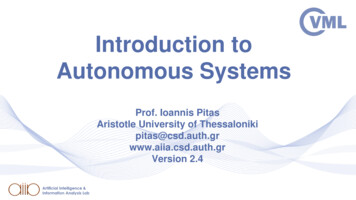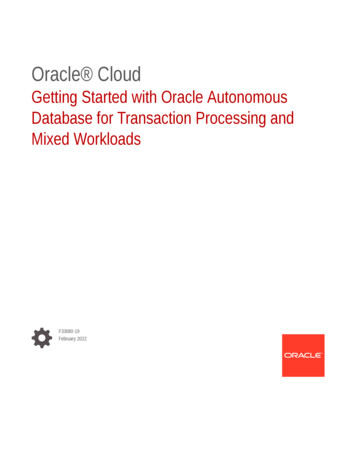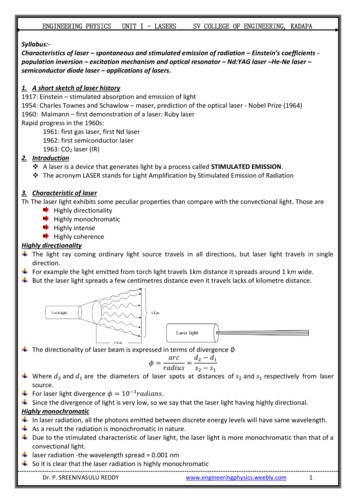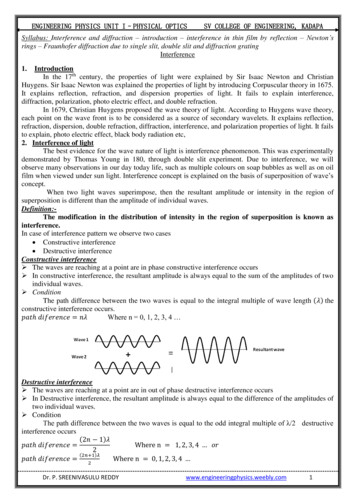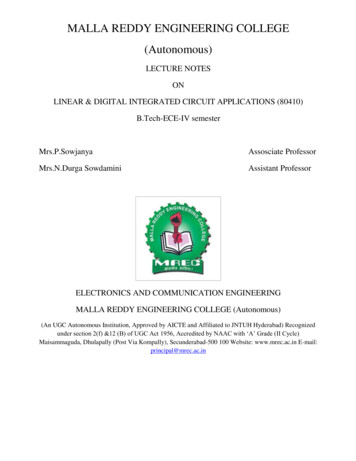
Transcription
MALLA REDDY ENGINEERING COLLEGE(Autonomous)LECTURE NOTESONLINEAR & DIGITAL INTEGRATED CIRCUIT APPLICATIONS (80410)B.Tech-ECE-IV semesterMrs.P.SowjanyaAssosciate ProfessorMrs.N.Durga SowdaminiAssistant ProfessorELECTRONICS AND COMMUNICATION ENGINEERINGMALLA REDDY ENGINEERING COLLEGE (Autonomous)(An UGC Autonomous Institution, Approved by AICTE and Affiliated to JNTUH Hyderabad) Recognizedunder section 2(f) &12 (B) of UGC Act 1956, Accredited by NAAC with „A‟ Grade (II Cycle)Maisammaguda, Dhulapally (Post Via Kompally), Secunderabad-500 100 Website: www.mrec.ac.in E-mail:principal@mrec.ac.in
2017-18MALLA REDDY ENGINEERING COLLEGEB.Tech.(MR-17)(Autonomous)V SemesterCode: 70414LINEAR & DIGITAL INTEGRATED CIRCUITAPPLICATIONSCredits: 3LTP3--Prerequisites: Switching Theory & Logic Design, Pulse & Digital Circuits.Course Objective: This course introduces the basic op-amp IC741 and study variouslinear and non-linear applications of op-amps. This also introduces the types of filters, timers andPLLs and their implementation and to design regulators, D-A & A-D converters andcombinational & sequential logic circuits.UNIT – I[8 Periods]INTEGRATED CIRCUITS AND OPERATIONAL AMPLIFIER: Introduction, Classification of IC„s,IC chip size and circuit complexity, basic information of Op-Amp, IC741Op-Amp and its features, the idealOperational amplifier, Op-Amp internal circuit, Op-Amp characteristics - DC and AC.UNIT – II[10 Periods]LINEAR APPLICATIONS OF OP-AMP: Inverting and non-inverting amplifiers, adder, subtractor,Instrumentation amplifier, AC amplifier, V to I and I to V converters, Integrator and differentiator.NON-LINEAR APPLICATIONS OF OP-AMP: Sample and Hold circuit, Log and Antilog amplifier,multiplier and divider, Comparators, Schmitt trigger, Multivibrators, Triangular and Square waveformgenerators, Oscillators.UNIT - III[10 Periods]ACTIVE FILTERS: Introduction, Butterworth filters – 1st order, 2nd order low pass and high pass filters,band pass, band reject and allpass filters.TIMER AND PHASE LOCKED LOOPS: Introduction to IC 555 timer, description of functionaldiagram, monostable and astable operations and applications, schmitt trigger, PLL - introduction, basicprinciple, phase detector/comparator, voltage controlled oscillator (IC 566), low pass filter, monolithic PLLand applications of PLL.UNIT - IV[10 Periods]VOLTAGE REGULATOR: Introduction, Series Op-Amp regulator, IC Voltage Regulators, IC 723general purpose regulators, Switching Regulator.D to A AND A to D CONVERTERS: Introduction, basic DAC techniques - weighted resistor DAC,R-2R ladder DAC, inverted R-2R DAC, A to D converters - parallel comparator type ADC, counter typeADC, successive approximation ADC and dual slope ADC, DAC and ADC Specifications.UNIT – V[10 Periods]CMOS LOGIC: CMOS logic levels, MOS transistors, Basic CMOS Inverter, NAND and NOR gates,CMOS AND-OR-INVERT and OR-AND-INVERT gates, implementation of function using CMOS logic.COMBINATIONAL CIRCUITS USING TTL 74XX ICS: Study of logic gates using 74XX ICs,Four-bit parallel adder(IC 7483), Comparator(IC 7485), Decoder(IC 74138, IC 74154),BCD-to-7-segment decoder(IC 7447), Encoder(IC 74147), Multiplexer(IC 74151), Demultiplexer (IC74154).SEQUNTIAL CIRCUITS USING TTL 74XX ICS: Flip Flops (IC 7474, IC 7473), Shift Registers,Universal Shift Register(IC 74194), 4- bit asynchronous binary counter(IC 7493).
TEXT BOOKS:1. D. Roy Choudhury, Shail B. Jain (2012), Linear Integrated Circuit, 4th edition, New Age InternationalPvt. Ltd., New Delhi, India.2. Ramakant A. Gayakwad, (2012), OP-AMP and Linear Integrated Circuits, 4th edition, Prentice Hall /Pearson Education, New Delhi.3. Floyd, Jain (2009), Digital Fundamentals, 8th edition, Pearson Education, New Delhi.REFERENCE BOOKS:1. Sergio Franco (1997), Design with operational amplifiers and analog integrated circuits, McGraw Hill,New Delhi.2. Gray, Meyer (1995), Analysis and Design of Analog Integrated Circuits, Wiley International, New Delhi.3. John F. Wakerly (2007), Digital Design Principles and practices, Prentice Hall / Pearson Education, NewDelhi.Text Books:1. S. Salivahanan, N Suresh Kumar, “Electronic Circuit Analysis”, Tata McGraw Hill EducationPrivate Limited, New Delhi, 2ndEdition, 2012.2. Jacob Milliman, Christos C. Halkias, Chetan D. Parikh “Integrated Electronics - Analog andDigital Circuits and Systems”, Tata McGraw Hill Education Private Limited, New Delhi,2ndEdition, 2011Reference Books:1. G. K. Mithal, “Electronic Devices and Circuits”, Khanna Publishers, New Delhi, 2nd Edition,1998.2. David A. Bell “Solid state pulse circuits”, Prentice Hall of India, New Delhi, India. 4th Edition,2002.E-RESOURCES:1. http://fmcet.in/ECE/EC6404 uw.pdf2. https://www.iare.ac.in/sites/default/files/lecture notes/LDIC%20Lecture%20Notes.pdf.3. http://smec.ac.in/sites/default/files/lecture ital%20IC%20Applications).pdf4. e 5. urnal/10470.6. -journal7. http://nptel.ac.in/courses/117107094/8. https://www.youtube.com/watch?v NVj Eu3sJL49. tegrated-Circuits
MODULE I: INTEGRATED CIRCUITS AND OPERATIONAL AMPLIFIERA simple electronic circuit can be designed easily because it requires few discrete electroniccomponents and connections. However, designing a complex electronic circuit is difficult, as itrequires more number of discrete electronic components and their connections. It is also timetaking to build such complex circuits and their reliability is also less. These difficulties can beovercome with Integrated Circuits.Integrated Circuit (IC)If multiple electronic components are interconnected on a single chip of semiconductor material,then that chip is called as an Integrated Circuit (IC). It consists of both active and passivecomponents.This chapter discusses the advantages and types of ICs.Advantages of Integrated CircuitsIntegrated circuits offer many advantages. They are discussed below Compact size For a given functionality, you can obtain a circuit of smaller size usingICs, compared to that built using a discrete circuit. Lesser weight A circuit built with ICs weighs lesser when compared to the weight of adiscrete circuit that is used for implementing the same function of IC. using ICs, comparedto that built using a discrete circuit. Low power consumption ICs consume lower power than a traditional circuit,because oftheir smaller size and construction. Reduced cost ICs are available at much reduced cost than discrete circuits because oftheir fabrication technologies and usage of lesser material than discrete circuits. Increased reliability Since they employ lesser connections, ICs offer increasedreliability compared to digital circuits. Improved operating speeds ICs operate at improved speeds because of their switchingspeeds and lesser power consumption.Types of Integrated CircuitsIntegrated circuits are of two types Analog Integrated Circuits and Digital IntegratedCircuits.Analog Integrated CircuitsIntegrated circuits that operate over an entire range of continuous values of the signal amplitudeare called as Analog Integrated Circuits. These are further classified into the two types asdiscussed here Linear Integrated Circuits An analog IC is said to be Linear, if there exists a linearrelation between its voltage and current. IC 741, an 8-pin Dual In-line Package (DIP)opamp, is an example of Linear IC.
Radio Frequency Integrated Circuits An analog IC is said to be Non-Linear, if thereexists a non-linear relation between its voltage and current. A Non-Linear IC is also calledas Radio Frequency IC.Digital Integrated CircuitsIf the integrated circuits operate only at a few pre-defined levels instead of operating for an entirerange of continuous values of the signal amplitude, then those are called as Digital IntegratedCircuits.In the coming chapters, we will discuss about various Linear Integrated Circuits and theirapplications.Classification of ICs (Integrated Circuits)Below is the classification of different types of ICs basis on their chip size. SSI: Small scale integration. 3 – 30 gates per chip.MSI: Medium scale integration. 30 – 300 gates per chip.LSI: Large scale integration. 300 – 3,000 gates per chip.VLSI: Very large scale integration. More than 3,000 gates per chip.Types of ICs (Integrated Circuits)Based on the method or techniques used in manufacturing them, types of ICs can be divided intothree classes:1. Thin and thick film ICs2. Monolithic ICs3. Hybrid or multichip ICsBelow is the simple explanation of different types of ICs as mentioned above.Thin and Thick ICs:In thin or thick film ICs, passive components such as resistors, capacitors are integrated but thediodes and transistors are connected as separate components to form a single and a completecircuit. Thin and thick ICs that are produced commercially are merely the combination ofintegrated and discrete (separate) components.Thick and thin ICs have similar characteristics, similar appearance except the method of filmdeposition. Method of deposition of films distinguished Thin ICs from Thick ICs.Thin film ICs are made by depositing films of a conducting material on a glass surface or on aceramic base. By varying the thickness of the films deposited on the materials having differentresistivity, Passive electronic components like resistors and capacitors can be manufactured.In Thick film ICs, silk printing technique is used to create the desired pattern of the circuit on aceramic substrate. Thick-film ICs are sometimes referred to as printed thin-film.The screens are actually made of fine stainless steel wire mesh and the links (connections) arepastes having conductive, resistive or dielectric properties. The circuits are fired in a furnace at ahigh temperature so as to fuse the films to the substrate after printing.
Monolithic ICsIn monolithic ICs, the discrete components, the active and the passive and also theinterconnections between then are formed on a silicon chip. The word monolithic is actuallyderived from two Greek words “mono” meaning one or single and Lithos meaning stone. Thusmonolithic circuit is a circuit that is built into a singlecrystal.Monolithic ICs are the most common types ICs in use today. Its cost of production is cheap and isreliable. Commercially manufactured ICs are used as amplifiers, voltage regulators, in AMreceivers, and in computer circuits. However, despite all these advantages and vast fields ofapplication of monolithic ICs, it has limitations. The insulation between the components ofmonolithic ICs is poor. It also have low power rating, fabrication of insulators is not that possibleand so many other factors.Advantages and Applications of ICsICs have advantages over those that are made by interconnecting discrete components some ofwhich are its small size. It is a thousand times smaller than the discrete circuits. It is an all in one(components and the interconnections are on a single silicon chip). It has little weight.Its cost of production is also low. It is reliable because there is no soldered joints. ICs consumeslittle energy and can easily be replaced when the need arises. It can be operated at a very hightemperature. different types of ICs are widely applied in our electrical devices such as high poweramplifiers, voltage regulators, TV receivers and computers etc.Limitation for different types of ICsDespite the advantages that ICs provide us with, it have limitations some of which are: Limited power ratingIt operates at low voltageHigh grade of PNP is not possibleIt produces noise during operationIts components such as resistors and capacitors are voltage dependentIt is delicate i.e it cannot withstand rough handling etc.Basics Of Operational AmplifierOperational Amplifier, also called as an Op-Amp, is an integrated circuit, which can be used toperform various linear, non-linear, and mathematical operations. An op-amp is a direct coupledhigh gain amplifier. You can operate op-amp both with AC and DC signals. This chapterdiscusses the characteristics and types of op-amps.
Construction of Operational AmplifierAn op-amp consists of differential amplifier(s), a level translator and an output stage. Adifferential amplifier is present at the input stage of an op-amp and hence an op-amp consistsof two input terminals. One of those terminals is called as the inverting terminal and the otherone is called as the non-inverting terminal. The terminals are named based on the phaserelationship between their respective inputs and outputs.Characteristics of Operational AmplifierThe important characteristics or parameters of an operational amplifier are as follows Open loop voltage gainOutput offset voltageCommon Mode Rejection RatioSlew RateThis section discusses these characteristics in detail as given below Open loop voltage gainThe open loop voltage gain of an op-amp is its differential gain without any feedback path.Mathematically, the open loop voltage gain of an op-amp is represented as Av v0/(v1 v2)Output offset voltageThe voltage present at the output of an op-amp when its differential input voltage is zero is calledas output offset voltage.Common Mode Rejection Ratio:Common Mode Rejection Ratio (CMRR) of an op-amp is defined as the ratio of the closed loopdifferential gain, AdAd and the common mode gain, AcAc.Mathematically, CMRR can be represented as CMRR AdAcCMRR AdAcNote that the common mode gain, AcAc of an op-amp is the ratio of the common mode outputvoltage and the common mode input voltage.Slew Rate:Slew rate of an op-amp is defined as the maximum rate of change of the output voltage due to astep input voltage.Mathematically, slew rate (SR) can be represented as SR Maximum of (dV0/dt)
Types of Operational Amplifiers:An op-amp is represented with a triangle symbol having two inputs and one output.Op-amps are of two types: Ideal Op-Amp and Practical Op-Amp.They are discussed in detail as given below Ideal Op-AmpAn ideal op-amp exists only in theory, and does not exist practically. The equivalent circuit of anideal op-amp is shown in the figure given below An ideal op-amp exhibits the following characteristics Input impedance Zi ΩOutput impedance Z0 0ΩOpen loop voltage gaine Av If (the differential) input voltage Vi 0V, then the output voltage will be V0 0V. Bandwidth is infinity. It means, an ideal op-amp will amplify the signals of any frequencywithout any attenuation. Common Mode Rejection Ratio (CMRR) is infinity. Slew Rate (SR) is infinity. It means, the ideal op-amp will produce a change in the outputinstantly in response to an input step voltage.
Practical Op-AmpPractically, op-amps are not ideal and deviate from their ideal characteristics because of someimperfections during manufacturing. The equivalent circuit of a practical op-amp is shown in thefollowing figure A practical op-amp exhibits the following characteristics Input impedance, Zi in the order of Mega ohms.Output impedance, Z0 in the order of fewohms.Open loop voltage gain, Av will be high.When you choose a practical op-amp, you should check whether it satisfies the followingconditions Input impedance, Zi should be as high as possible.Output impedance, Z0 should be as low as possible.Open loop voltage gain, Av should be as high as possible. Output offset voltage should be as low as possible. The operating Bandwidth should be as high as possible. CMRR should be as high as possible. Slew rate should be as high as possible.Note IC 741 op-amp is the most popular and practical op-amp.
AC and DC performance characteristics of op-amp in detail.Dc characteristics: An ideal op- amp draws no current from the source and its response is alsoindependent of temperature. However, a real op-amp does not work this way. Current is takenfrom the source into the op-amp inputs. Also the inputs respond differently to current and voltagedue to mismatch in transistors. A real op-amp also shifts its operation with temperature. Thesenon- ideal dc characteristics that add error components to the dc output voltage are:1. Input bias current2. Input offset current3. Input offset voltage4. Thermal drift1. Input bias current: It is defined as the average value of the base currents entering into theinput terminals of an op-amp during the input bias current. The op-amp input is a differentialamplifier, which may be made of BJT or FET. In either case, the input transistors must be biasedinto their linear region by supplying 7 currents into the bases by the external circuit.In an ideal op-amp we assume that no current is drawn from the input terminals. However,practically, input terminals do conduct a small value of dc current to bias the input transistors. Thebase currents entering into the inverting and non-inverting terminals are shown as IB (-) and IB ( ) respectively. Even though both the transistors are identical, IB (-) and IB ( ) are not exactlyequal due to internal imbalances between the two inputs.IB IB ( ) IB (-)/ 2 ,Where IB ( ) – bias current at non- inverting terminal IB (-) - biascurrent at inverting terminal Input bias current compensation: IB for BJT is 500mA IB for FETis 50pA By introducing compensation resistor at the non-inverting input terminal we can able toreduce the input bias current. Rcomp R1/ Rf (R1* Rf) / (R1 Rf)2. Input offset current: Bias current compensation will work efficiently if both the bias currentsIB ( ) and IB (-) are equal. The input transistors cannot be made identical. Hence there will bedifference in bias currents. This difference is called as input offset current Ios and can be writtenas Ios IB ( ) – IB (-) The absolute value sign indicates that there is no way to predict whichof the bias currents will be larger. Input offset current for BJT is 200nA. Input offset current forFET is 10pA. The effect of Ios can be minimized by having the feedback resistor value to besmall.3. Input offset voltage: In spite of the use of the above compensation techniques, it is found thatthe output voltage may still not be zero with zero input voltage. This is due to unavoidableimbalances inside the op-amp and one may have to apply a small voltage at the input terminals tomake output voltage zero. This voltage is called input offset voltage Vios. This is the voltagerequired to be applied at the input for making output voltage to zero volts. The voltage V2 atnegative terminal is V2 R 1.V0/R1 Rf Or V0 (R1 Rf)V2/R1 (1 Rf/R1)V2 Since VOS Vi –V2 and Vi 0 VOS 0 –V2 V24. Thermal drift: Bias current, offset current and offset voltage change with temperature. Acircuit carefully mulled at 25 degree Celsius may not remain so when the temperature rises to 35degree Celsius. This is called drift. Often, offset current drift is expressed in nA/0C and offsetvoltage drift in mV/0C.These indicate the change in offset for each degree Celsius change in temperature. 8 There arevery few circuit techniques that can be used to minimize the effect of drift. Careful printed circuitboard layout must be equal be used to keep op-amps away from source of heat. Forced air coolingmay be used to stabilize the ambient temperature.
Ac characteristics:For small signal sinusoidal applications the a.c. characteristics are1. Frequency response2. Slew rate1. Frequency response: An ideal op-amp has infinite band width that is open loop gain is 90dBwith d.c.signal and this gain should remain the same through audio and radio frequency. Butpractically op-amp gain decreases at high frequency. This is due to a capacitive component in theequivalent circuit of op-amp. Due to R0C, the gain decreases by 20 dB per decay and thefrequency is said to be brake or corner frequency and is given by f1 1/ (2*3.14*R0*C) A A0*L/ (1 (f/f1) 2)2. Slew rate: The slew rate is defined as the maximum rate of change of output voltage caused bya step input voltage and is usually specified in V/µs. for e.g. A 1V/µs slew rate means that theoutput rises or falls by 1V in one 1µs. The rate of change of output voltage due to the step inputvoltage and is usually specified as V/micro sec. For example: 1V/micro sec. slew rate denotes theoutput rises or falls by 1 volts in 1 micro seconds. The rate at which the voltage across thecapacitor dVc/dt is given by dVc/dt I/C Slew rate SR dVc/dt max Imax/ C For IC741 Imax 15micro amps, C 30 Pico farad Slew rate 0.5V/ micro sec.
MODULE II: LINEAR & NON-LINEAR APPLICATIONS OF OP-AMPOp-Amp-ApplicationsA circuit is said to be linear, if there exists a linear relationship between its input and the output.Similarly, a circuit is said to be non-linear, if there exists a non-linear relationship between itsinput and output.Op-amps can be used in both linear and non-linear applications. The following are the basicapplications of op-amp Inverting AmplifierNon-inverting AmplifierVoltage followerThis chapter discusses these basic applications in detail.Inverting AmplifierAn inverting amplifier takes the input through its inverting terminal through a resistor R1R1, andproduces its amplified version as the output. This amplifier not only amplifies the input but alsoinverts it (changes its sign).The circuit diagram of an inverting amplifier is shown in the following figure Note that for an op-amp, the voltage at the inverting input terminal is equal to the voltage at itsnon-inverting input terminal. Physically, there is no short between those two terminalsbut virtually, they are in short with each other.In the circuit shown above, the non-inverting input terminal is connected to ground. That meanszero volts is applied at the non-inverting input terminal of the op-amp.
According to the virtual short concept, the voltage at the inverting input terminal of an op-ampwill be zero volts.The nodal equation at this terminal's node is as shown below 0 ViR1 0 V0Rf 00 ViR1 0 V0Rf 0 ViR1 V0Rf ViR1 V0Rf V0 ( RfR1)Vt V0 ( RfR1)Vt V0Vi RfR1 V0Vi RfR1The ratio of the output voltage V0V0 and the input voltage ViVi is the voltage-gain or gain of theamplifier. Therefore, the gain of inverting amplifier is equal to RfR1 RfR1.Note that the gain of the inverting amplifier is having a negative sign. It indicates that there existsa 1800 phase difference between the input and the output.Non-Inverting AmplifierA non-inverting amplifier takes the input through its non-inverting terminal, and produces itsamplified version as the output. As the name suggests, this amplifier just amplifies the input,without inverting or changing the sign of the output.The circuit diagram of a non-inverting amplifier is shown in the following figure In the above circuit, the input voltage ViVi is directly applied to the non-inverting input terminalof op-amp. So, the voltage at the non-inverting input terminal of the op-amp will be ViVi.By using voltage division principle, we can calculate the voltage at the inverting input terminalof the op-amp as shown below V1 V0(R1R1 Rf) V1 V0(R1R1 Rf)
According to the virtual short concept, the voltage at the inverting input terminal of an op-amp issame as that of the voltage at its non-inverting input terminal. V1 Vi V1 Vi V0(R1R1 Rf) Vi V0(R1R1 Rf) Vi V0Vi R1 RfR1 V0Vi R1 RfR1 V0Vi 1 RfR1 V0Vi 1 RfR1Now, the ratio of output voltage V0V0 and input voltage ViVi or the voltage-gain or gain of thenon-inverting amplifier is equal to 1 RfR11 RfR1.Note that the gain of the non-inverting amplifier is having a positive sign. It indicates that there isno phase difference between the input and the output.Voltage followerA voltage follower is an electronic circuit, which produces an output that follows the inputvoltage. It is a special case of non-inverting amplifier.If we consider the value of feedback resistor, RfRf as zero ohms and (or) the value of resistor, 1 asinfinity ohms, then a non-inverting amplifier becomes a voltage follower. The circuit diagram ofa voltage follower is shown in the following figure In the above circuit, the input voltage ViVi is directly applied to the non-inverting input terminalof the op-amp. So, the voltage at the non-inverting input terminal of op-amp is equal to ViVi.Here, the output is directly connected to the inverting input terminal of opamp. Hence, the voltageat the inverting input terminal of op-amp is equal to V0V0.According to the virtual short concept, the voltage at the inverting input terminal of the op-ampis same as that of the voltage at its non-inverting input terminal. V0 Vi V0 ViSo, the output voltage V0V0 of a voltage follower is equal to its input voltage ViVi.Thus, the gain of a voltage follower is equal to one since, both output voltage V0V0 and inputvoltage ViVi of voltage follower are same.
Arithmetic CircuitsIn the previous chapter, we discussed about the basic applications of op-amp. Note that they comeunder the linear operations of an op-amp. In this chapter, let us discuss about arithmetic circuits,which are also linear applications of op-amp.The electronic circuits, which perform arithmetic operations are called as arithmetic circuits.Using op-amps, you can build basic arithmetic circuits such as an adder and a subtractor. In thischapter, you will learn about each of them in detail.AdderAn adder is an electronic circuit that produces an output, which is equal to the sum of the appliedinputs. This section discusses about the op-amp based adder circuit.An op-amp based adder produces an output equal to the sum of the input voltages applied at itsinverting terminal. It is also called as a summing amplifier, since the output is an amplified one.The circuit diagram of an op-amp based adder is shown in the following figure In the above circuit, the non-inverting input terminal of the op-amp is connected to ground. Thatmeans zero volts is applied at its non-inverting input terminal.According to the virtual short concept, the voltage at the inverting input terminal of an op-amp issame as that of the voltage at its non-inverting input terminal. So, the voltage at the inverting inputterminal of the op-amp will be zero volts.The nodal equation at the inverting input terminal's node is0 V1R1 0 V2R2 0 V0Rf 00 V1R1 0 V2R2 0 V0Rf 0 V1R1 V2R2 V0Rf V1R1 V2R2 V0Rf V0 Rf(V1R1 V2R2) V0 Rf(V1R1 V2R2)If Rf R1 R2 RRf R1 R2 R, then the output voltage V0V0 will be V0 R(V1R V2R)V0 R(V1R V2R) V0 (V1 V2) V0 (V1 V2)
Therefore, the op-amp based adder circuit discussed above will produce the sum of the two inputvoltages v1v1 and v1v1, as the output, when all the resistors present in the circuit are of samevalue. Note that the output voltage V0V0 of an adder circuit is having a negative sign, whichindicates that there exists a 1800 phase difference between the input and the output.SubtractorA subtractor is an electronic circuit that produces an output, which is equal to the difference of theapplied inputs. This section discusses about the op-amp based subtractor circuit.An op-amp based subtractor produces an output equal to the difference of the input voltagesapplied at its inverting and non-inverting terminals. It is also called as a difference amplifier,since the output is an amplified one.The circuit diagram of an op-amp based subtractor is shown in the following figure Now, let us find the expression for output voltage V0V0 of the above circuit using superpositiontheorem using the following steps
Step 1Firstly, let us calculate the output voltage V01V01 by considering only V1V1.For this, eliminate V2V2 by making it short circuit. Then we obtain the modified circuitdiagram as shown in the following figure Now, using the voltage division principle, calculate the voltage at the non-inverting inputterminal of the op-amp. Vp V1(R3R2 R3) Vp V1(R3R2 R3)Now, the above circuit looks like a non-inverting amplifier having input voltage VpVp. Therefore,the output voltage V01V01 of above circuit will beV01 Vp(1 RfR1)V01 Vp(1 RfR1)Substitute, the value of VpVp in above equation, we obtain the output voltage V01V01 byconsidering only V1V1, as V01 V1(R3R2 R3)(1 RfR1)V01 V1(R3R2 R3)(1 RfR1)Step 2In this step, let us find the output voltage, V02V02 by considering only V2V2. Similar to that inthe above step, eliminate V1V1 by making it short circuit. The modified circuit diagram isshown in the following figure.
You can observe that the voltage at the non-inverting input terminal of the op-amp will be zerovolts. It means, the above circuit is simply an inverting op-amp. Therefore, the outputvoltage V02V02 of above circuit will be V02 ( RfR1)V2V02 ( RfR1)V2Step 3In this step, we will obtain the output voltage V0V0 of the subtractor circuit by adding the outputvoltages obtained in Step1 and Step2. Mathematically, it can be written asV0 V01 V02V0 V01 V02Substituting the values of V01V01 and V02V02 in the above equation, we get V0 V1(R3R2 R3)(1 RfR1) ( RfR1)V2V0 V1(R3R2 R3)(1 RfR1) ( RfR1)V2 V0 V1(R3R2 R3)(1 RfR1) (RfR1)V2 V0 V1(R3R2 R3)(1 RfR1) (RfR1)V2If Rf R1 R2 R3 RRf R1 R2 R3 R, then the output voltage V0V0 will beV0 V1(RR R)(1 RR) (RR)V2V0 V1(RR R)(1 RR) (RR)V2 V0 V1(R2R)(2) (1)V2 V0 V1(R2R)(2) (1)V2V0 V1 V2V0 V1 V2Thus, the op-amp based subtractor circuit discussed above will produce an output, which is thedifference of two input voltages V1V1 and V2V2, when all the resistors present in the circuit areof same value.
Instrumentation AmplifierInstrumentation Amplifiers are basically used to amplify small differential signals. InstrumentationAmplifier provides the most important function of Common-Mode Rejection (CMR). It cancels outany signals that have the same potential on both the inputs. The signals that have a potentialdifference between the inputs get amplified.An Instrumentation Amplifier (In-Amp) is used for low-
Operational amplifier, Op-Amp internal circuit, Op-Amp characteristics - DC and AC. UNIT – II [10 Periods] LINEAR APPLICATIONS OF OP-AMP: Inverting and non-inverting amplifiers, adder, subt

